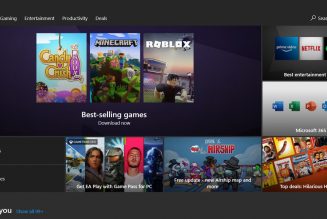
In recent months you may have heard about something called the metaverse. Maybe you’ve read that the metaverse is going to replace the internet. Maybe we’re all supposed to live there. Maybe Facebook (or Epic, or Roblox, or dozens of smaller companies) is trying to take it over. And maybe it’s got something to do with NFTs?
Unlike a lot of things The Verge covers, the metaverse is tough to explain for one reason: it doesn’t necessarily exist. It’s partly a dream for the future of the internet and partly a neat way to encapsulate some current trends in online infrastructure, including the growth of real-time 3D worlds.
But let’s get to the fun part. Will you start checking your Facebook feed in Fortnite with a pair of augmented reality glasses? Will your friends invite you to cyber-brunch instead of normal brunch? Time to jack in and figure it out.
So, the metaverse. That started as a science fiction thing, right?
Correct. Neal Stephenson famously coined the term “metaverse” in his 1992 novel Snow Crash, where it referred to a 3D virtual world inhabited by avatars of real people. Lots of other science fiction media includes metaverse-like systems (some of them predating Snow Crash). But Stephenson’s book remains one of the most common reference points for metaverse enthusiasts, along with Ernest Cline’s 2011 novel Ready Player One.
Aren’t both those books set in horrible dystopias?
Snow Crash’s metaverse is an outgrowth of Stephenson’s satirical corporation-dominated future America, but it’s undeniably depicted as having a cool side. (The protagonist is a master hacker who gets in katana fights at a virtual nightclub. No amount of narrative self-awareness can fool readers into thinking that’s not supposed to be fun.) Ready Player One’s virtual world is symbolically named the OASIS, and Cline portrays it as an almost utopian source of escapism in a horrible future.
On one hand, emulating the virtual worlds of Snow Crash or Ready Player One is less deliberately creepy than naming your tech initiative “Skynet” or your nutrient shake after Soylent Green. On the other hand, science fiction stories can conjure a vivid picture of “the metaverse” without illuminating how it should work or why it should exist.
Then what is the real metaverse?
There’s no universally accepted definition of a real “metaverse,” except maybe that it’s a fancier successor to the internet. Silicon Valley metaverse proponents sometimes reference a description from venture capitalist Matthew Ball, author of the extensive Metaverse Primer:
“The Metaverse is an expansive network of persistent, real-time rendered 3D worlds and simulations that support continuity of identity, objects, history, payments, and entitlements, and can be experienced synchronously by an effectively unlimited number of users, each with an individual sense of presence.”
Facebook, arguably the tech company with the biggest stake in the metaverse, describes it more simply:
“The ‘metaverse’ is a set of virtual spaces where you can create and explore with other people who aren’t in the same physical space as you.”
There are also broader metaverse-related taxonomies like one from game designer Raph Koster, who draws a distinction between “online worlds,” “multiverses,” and “metaverses.” To Koster, online worlds are digital spaces — from rich 3D environments to text-based ones — focused on one main theme. Multiverses are “multiple different worlds connected in a network, which do not have a shared theme or ruleset,” including Ready Player One’s OASIS. And a metaverse is “a multiverse which interoperates more with the real world,” incorporating things like augmented reality overlays, VR dressing rooms for real stores, and even apps like Google Maps.
If you want something a little snarkier and more impressionistic, you can cite digital scholar Janet Murray — who has described the modern metaverse ideal as “a magical Zoom meeting that has all the playful release of Animal Crossing.”
But wait, now Ready Player One isn’t a metaverse and virtual worlds don’t have to be 3D? It sounds like some of these definitions conflict with each other.
An astute observation.
Look, I just read an article saying we were all going to live in the metaverse, and I want to know what that means.
Right now, tech industry figures who talk about “the metaverse” are usually excited about digital platforms that include some of the following things:
- Feature sets that overlap with older web services or real-world activities
- Real-time 3D computer graphics and personalized avatars
- A variety of person-to-person social interactions that are less competitive and goal-oriented than stereotypical games
- Support for users creating their own virtual items and environments
- Links with outside economic systems so people can profit from virtual goods
- Designs that seem well-suited to virtual and augmented reality headsets, even if they usually support other hardware as well
But in most current discourse, “the metaverse” arguably isn’t a fixed set of attributes. It’s an aspirational term for a future digital world that feels more tangibly connected to our real lives and bodies.
So is Fortnite a metaverse? Or Facebook Horizon? Or is the metaverse all of them put together?
People like Tim Sweeney (CEO of Fortnite publisher Epic) and Facebook CEO Mark Zuckerberg often say they’re just building one piece of a larger interconnected metaverse, similar to an individual social network on the present-day internet. “The metaverse isn’t a single product one company can build alone. Just like the internet, the metaverse exists whether Facebook is there or not,” one recent Facebook statement reads.
But informally, “metaverse” is also used to describe a single platform that meets the criteria listed above. Second Life, a virtual world that isn’t a traditional game, has been frequently described as a metaverse. Sweeney has described Fortnite’s user experience as a metaverse because it’s a virtual 3D space that mixes gaming and non-gaming elements. Roblox CEO David Baszucki coyly notes that “some people refer to what we’re building as the Metaverse.”
If you like Koster’s “multiverse” definition, there are also arguably several standalone multiverses. Microsoft’s Minecraft gets less hype than Roblox these days, but it enables similar activities through modding. So do lower-profile services like The Sandbox, which incorporates a complex cryptocurrency-based economy as well.
Why is the term “metaverse” even useful? “The internet” already covers mobile apps, websites, and all kinds of infrastructure services. Can’t we roll virtual worlds in there, too?
Matthew Ball favors the term “metaverse” because it creates a clean break with the present-day internet. “Using the metaverse as a distinctive descriptor allows us to understand the enormity of that change and in turn, the opportunity for disruption,” he said in a phone interview with The Verge. “It’s much harder to say ‘we’re late-cycle into the last thing and want to change it.’ But I think understanding this next wave of computing and the internet allows us to be more proactive than reactive and think about the future as we want it to be, rather than how to marginally affect the present.”
A more cynical spin is that “metaverse” lets companies dodge negative baggage associated with “the internet” in general and social media in particular. “As long as you can make technology seem fresh and new and cool, you can avoid regulation,” researcher Joan Donovan told The Washington Post in a recent article about Facebook and the metaverse. “You can run defense on that for several years before the government can catch up.”
There’s also one very simple reason: it sounds more futuristic than “internet” and gets investors and media people (like us!) excited.
Didn’t we have a whole metaverse hype cycle around Second Life in the ‘00s? What’s different now?
It’s true: plenty of new “metaverse” phenomena aren’t really novel. People were becoming digital land barons and selling virtual items in Second Life nearly two decades ago. Schools and businesses have opened satellite campuses in that world and others. Social 3D spaces like CyberTown long predate Second Life. Even before that, early virtual worlds popped up in the 1970s with text-based multiuser dungeons or MUDs. Many older worlds also inspired the kinds of utopian predictions we see around the metaverse today.
One reason we might be experiencing the hype cycle again is that graphics technology and internet connectivity has significantly advanced since, say, Second Life’s 2003 launch. Many video games operate under a “live service” model where the developers constantly update a game to encourage players to return, creating a more convincing illusion of a living, breathing, ever-changing world. Non-metaverse games like League of Legends or Overwatch make significant changes to gameplay years after release, treating the experience more like a virtual space than a static game. From there, a leap to in-game concerts and fashion shows doesn’t seem that far.
Virtual and augmented reality have gotten closer to consumer application, even if VR remains niche and AR nascent. One estimate suggests Facebook has sold around 8 million Oculus Quest 2 headsets, and several dozen VR games have made over $1 million in sales. Those are tiny numbers compared to phone and console sales, but huge compared to the practically nonexistent home VR market 10 years ago. Apple is reportedly working on VR / AR headsets, and Chinese company Nreal has successfully shipped full-fledged consumer AR sunglasses at a comparatively low price.
Another possible reason is that modern pop culture is built on sprawling and highly intertextual media franchises owned by a few companies that promote their huge intellectual property catalogs as shared universes. That enthusiasm has translated into dreams of — as Verge editor Liz Lopatto describes it — “an online haven where superhero IP owned by different companies can finally kiss.” (This is the entire premise of Ready Player One.)
And if you believe the metaverse shouldn’t be owned by a handful of companies, there are new technologies that could facilitate less centralized virtual worlds, like cryptocurrency and non-fungible tokens or NFTs. These metaverse visions overlap with the concept of Web3, a term covering decentralized internet services where users retain more personal control over the data they put online.
Or maybe we’re in a global pandemic that’s kept billions of people away from casual real-world human contact for more than a year?
Or that.
People keep saying NFTs are part of the metaverse. Why?
NFTs are complicated in their own right, and you can read more about them here. Loosely, the thinking goes: NFTs are a way of recording who owns a specific virtual good, creating and transferring virtual goods is a big part of the metaverse, thus NFTs are a potentially useful financial architecture for the metaverse. Or in more practical terms: if you buy a virtual shirt in Metaverse Platform A, NFTs can create a permanent receipt and let you redeem the same shirt in Metaverse Platforms B to Z.
Lots of NFT designers are selling collectible avatars like CryptoPunks, Cool Cats, and Bored Apes, sometimes for astronomical sums. Right now these are mostly 2D art used as social media profile pictures. But we’re already seeing some crossover with “metaverse”-style services. The company Polygonal Mind, for instance, is building a system called CryptoAvatars that lets people buy 3D avatars as NFTs and then use them across multiple virtual worlds.
Is using one avatar or item across different worlds as simple as it sounds?
On the contrary, people like Raph Koster think it’s one of the metaverse’s toughest problems.
There are a few ways designers support people “moving” items between worlds right now. One is to build all the worlds within a single platform like Roblox, where players can do things like accessorize an avatar with virtual gear and use it across different experiences. But this breaks down across worlds that are more technically and aesthetically different. Even leaving aside wonky problems like file format support, something as simple as a 3D hat model might look good on a Lego-like Roblox character but make no sense on a pixelated avatar from Minecraft. An item might have a particular ability in one world (like playing music) that another world doesn’t support at all.
A second option is to manually create a different version of the same asset for every world. Fortnite and Halo both feature Master Chief avatars, for instance, but with a design tailored to each game. (This is typically how media franchises kiss with the companies’ official blessing — Warner Bros. can’t just take a Bruce Wayne model from the Batman: Arkham series and drop it in a Lego Batman game.)
This method can look seamless to users, but it can be a lot of work for developers and not worth the payoff in all cases. Epic and Microsoft might both benefit by adding a popular character to a popular game, but does Microsoft really want to model its own version of every single Fortnite skin for Minecraft, just so players can use another company’s avatars in its world?
A third option, available in the popular virtual world VRChat, is having players or third-party designers upload their own 3D models with a specific set of characteristics. But uploading a model demands more work and technical skill from users. (Arguably this is the closest analog to Stephenson’s Metaverse, where a good avatar requires either money or great computer skills.) Meanwhile, the developers cede some control over the aesthetic of their space. And if companies approach them with deals for licensed characters or items, they could find a world already populated by knockoffs.
This could change in the future. Epic could try to implement a shared item library for its popular Unreal Engine, for example. New AI visual filters could tweak a single 3D model to match different world designs the way existing ones turn selfies into anime. But any fix would require a level of coordination that we haven’t seen so far.
Is the metaverse a kind of internet? Will it replace the internet?
People are certainly talking about it that way! In an interview with The Verge, Mark Zuckerberg described the metaverse as “an embodied internet,” basically an upgraded version of the internet where people can have “different experiences that you couldn’t necessarily do on a 2D app or webpage.”
Tim Sweeney takes a similar line in The Washington Post, imagining the metaverse as “a kind of online playground where users could join friends to play a multiplayer game like Epic’s ‘Fortnite’ one moment, watch a movie via Netflix the next.” If you’re imagining a place where you can watch videos, play games with friends, and buy things, it’s going to end up looking a lot like the internet.
One of the metaverse’s key benefits is supposed to be “presence” — a sense that you’re physically engaging with places and people instead of watching them through a window. Gathering your co-workers around a virtual table in a service like Spatial and Facebook Horizon, for instance, could feel more natural to some people than looking at a grid of Zoom thumbnails.
But many pieces seem as likely to supplement the internet as replace it. A virtual dressing room makes sense if you want to see how an outfit would look on you. It doesn’t necessarily require a whole virtual store, though, just an easy way to switch between flat and spatial experiences. A good comparison point might be the mobile internet, which saw a slew of app-based services supplement or even replace traditional websites — but hasn’t made desktop-based options obsolete, either.
A text-heavy, non-real-time internet also has some noteworthy advantages. High-end computers, gaming consoles, and VR headsets that support detailed virtual environments can be expensive. People with mobility issues or slow internet connections might find moving an avatar around a real-time 3D world inconvenient. And people with low or no vision can use screen readers to access text on webpages, while navigating an environment based on images can be harder. Accessibility experts can help mitigate these issues, but there’s still a long way to go before they’re solved.
Will the metaverse turn into just another form of advertising, like social media?
People like Tim Sweeney say they don’t want it to. Sweeney told The Washington Post that present-day social media has “trapped” companies and users in walled gardens and bombarded them with ads. Roblox designers make money that’s not ad-driven by selling digital goods in their individual worlds and letting the company take a (sometimes surprisingly large) cut. Proponents of new options like NFTs see them as a viable alternative to ad-supported systems, although NFTs have potential negative side effects of their own.
But “advertising” is a slippery word. Fortnite, Sweeney’s version of a world beyond ads, is still packed absolutely full of big pop culture franchises and brands building name recognition — in the same Post interview, he imagined auto companies dropping models of their cars into the metaverse to let people test-drive them. With varying levels of skepticism, media coverage refers to the metaverse as “an expansive, digitized communal space where users can mingle freely with brands” or “a realm of culture and digital identity for brands to further discover their fullest potential.”
This might not come as a shock to fans of Snow Crash, where brands have supplanted nations, or Ready Player One, where pop culture franchises have all but conquered reality. Fortunately, if it doesn’t sound like much fun, there’s still time to help shape the future of the metaverse — assuming it actually arrives.









